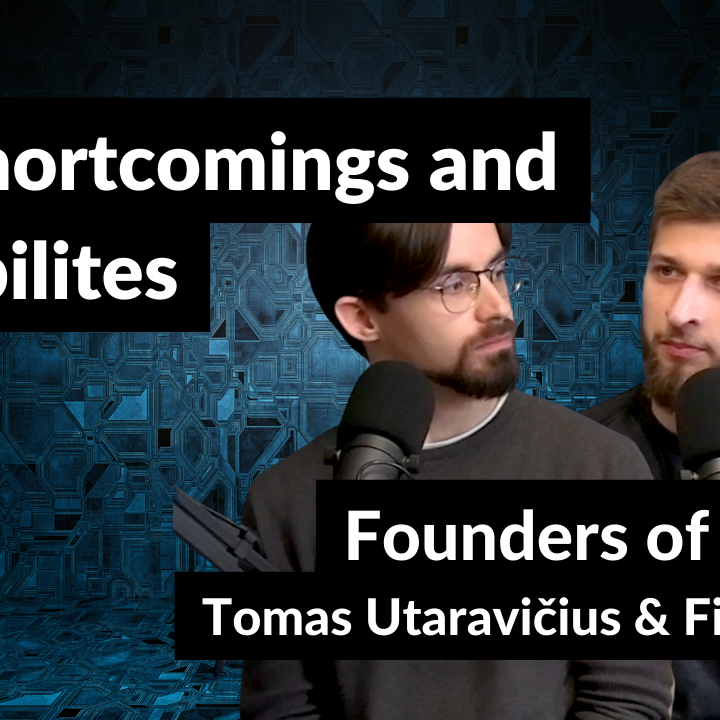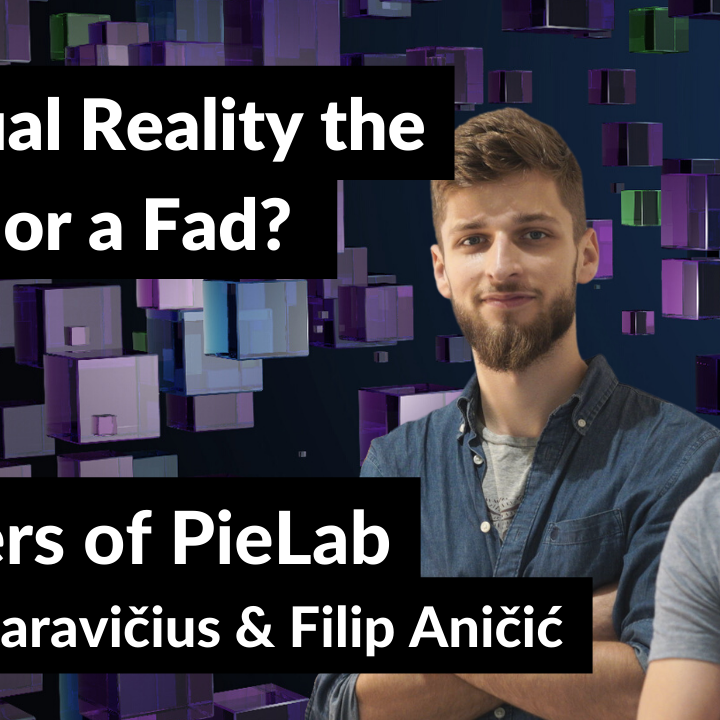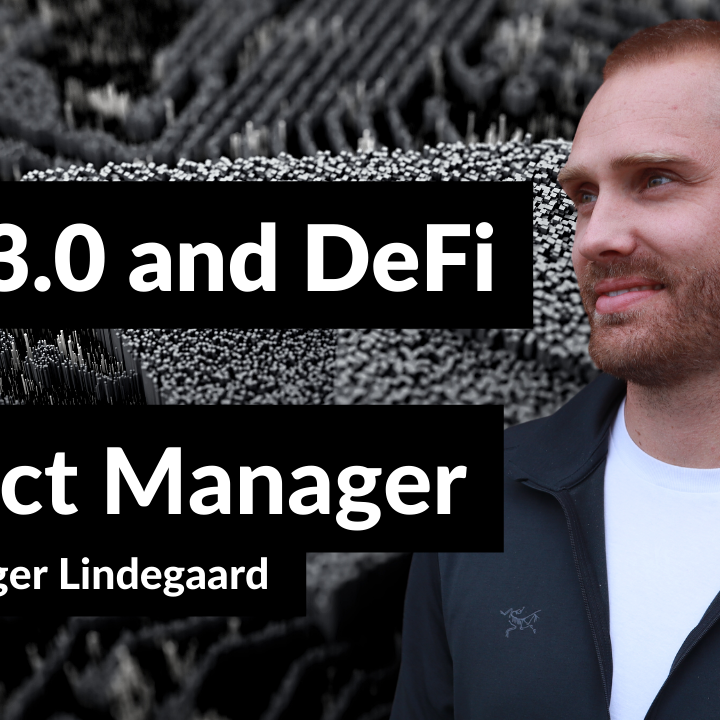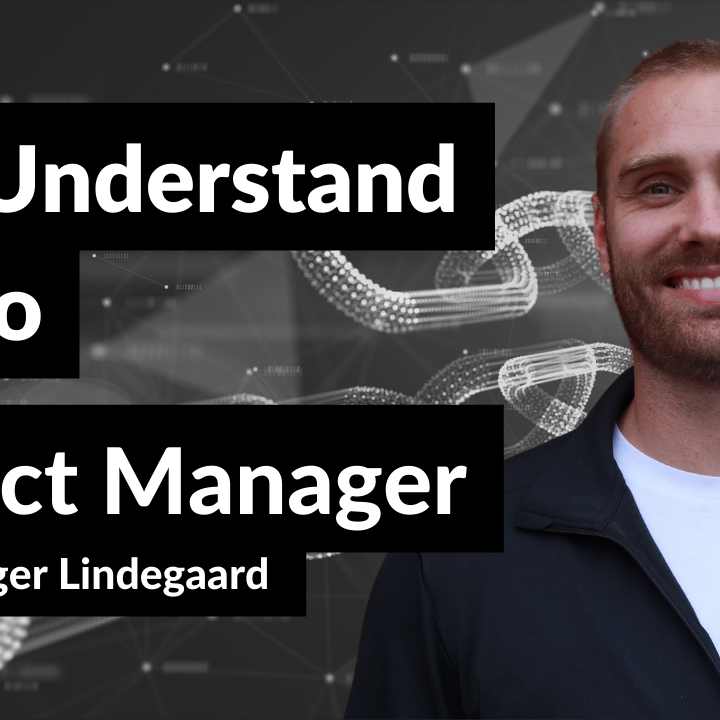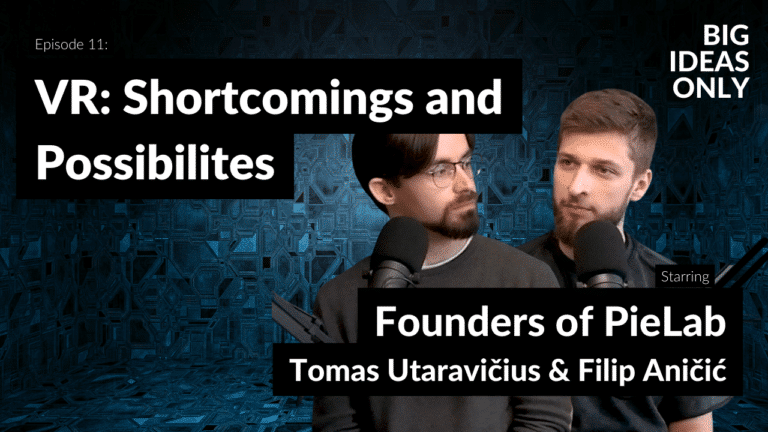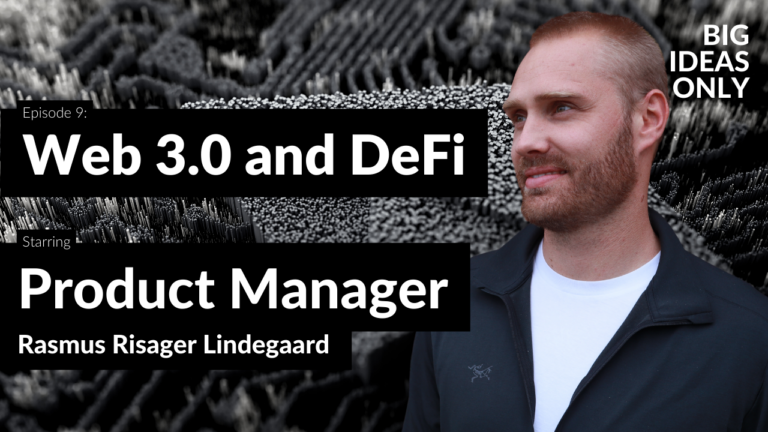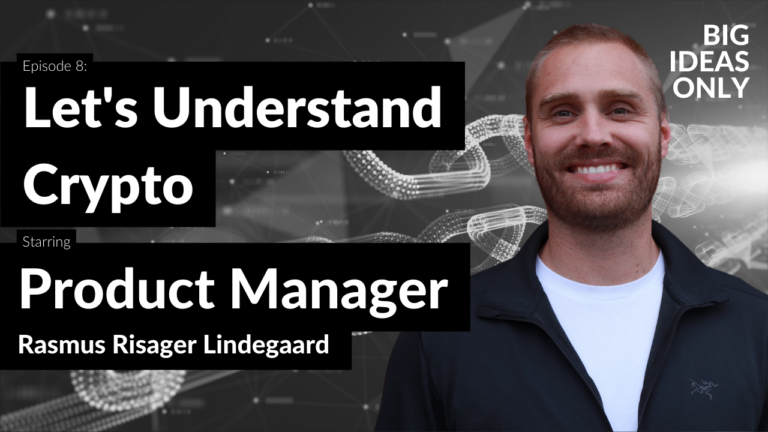To explain these futuristic phenomena, the founders and partners of the VR and AR studio PieLab; Tomas Utaravičius and Filip Aničić have come to our rescue.
Your host is Mikkel Svold, CEO of Montanus, who will guide you through this interesting topic.
This podcast is produced by Montanus.
Link up with Tomas Utaravičius
Link up with Filip Aničić
Link up with Mikkel Svold
Link up with Rasmus Risager Lindegaard
Link up with Mikkel Svold
Listed below are the most essential timestamps from the podcast episode to make it easier for you to find the topics that interest you.
00:23 Welcome
01:33 What are virtual reality and augmented reality?
02:52 Is virtual and augmented reality a fad?
04:57 What is Pielab?
06:37 What makes these technologies interesting?
08:15 Live experience versus the virtual experience
10:00 Gaming
12:18 Using virtual reality in education
18:01 Google glasses and privacy issues
19:25 Teaching with VR/AR while keeping it human
25:34 Outro
Recommended
Mikkel Svold (00:23):
Hello and welcome to Big Ideas Only. This is a podcast powered by Montanus, that is a marketing agency where we specialize in producing high quality content for marketing departments in engineering and knowledge-driven companies, mostly that is.
Today, we’ll focus on the funky world of virtual and augmented reality, whatever that means. And of course, if you haven’t come across these two ideas before, don’t worry because I have some good people in the studio with me to explain first of all what it is and more importantly, why it’s any good.
My name is Mikkel Svold, and I’ll be asking all the dumb questions to get us up to speed with this, I guess, futuristic phenomena that’s been around for a decade or so. And in the studio today I have, like I said, two guests, both of them, founders and partners in the VR and AR studio PieLab. First, welcome to you Tomas Utaravičius.
Tomas Utaravičius (01:21):
Thank you.
Mikkel Svold (01:22):
Oh, that was close. Utaravičius. And second, welcome to you Filip Aničić. And-
Filip Aničić (01:28):
Thank you.
Mikkel Svold (01:28):
… of course, please do excuse my slaughtering of both of your names.
Filip Aničić (01:32):
No worries.
Mikkel Svold (01:33):
I was really trying my best. In my invitation email, I called this episode Virtual Reality, Fad or Future? But before asking that question, Tomas, can you briefly just explain us what is virtual reality or VR? And what is AR augmented reality? And what are the differences? So VR and AR.
Tomas Utaravičius (01:56):
All right. So to put it short, virtual reality is basically a computer-generated world in 3D, where a person can participate and interact with. And augmented reality is very much the same except it’s basically a 3D world that comes on top of it.
Mikkel Svold (02:15):
And what does that mean?
Tomas Utaravičius (02:18):
So, if you have a real world hugely augmented with 3D features, you can put objects on it, you can make things look different, you can make things interactive.
Mikkel Svold (02:28):
Yeah. So the example that most or a lot of people will know is the Pokemon Go where you film through and see it through your iPhone or whatever, and then you have that list, like as Pokemon actually played it.
Tomas Utaravičius (02:41):
Yeah, exactly, exactly. In Pokemon Go, your device is basically able to recognize the ground and able to play some objects on it. And that’s the most basic form of augmented reality.
Mikkel Svold (02:52):
Okay, cool. And now Filip, I was also asking whether it’s like a fad or the future. And is virtual reality and augmented reality, is that a fad you think?
Filip Aničić (03:08):
I have an interesting answer for that. I think it’s both. It is the future, but I think it’s also fad. The reason being is that, like in the early 2000s, there was a big dotcom boom where everyone want to make a website and that. And then, the market just blew out and then, there’s the difference. There’s the reality of where the technology is and the status of it. And I think we see a very high value there, very high potential in the technology itself. It’s science fiction, basically. It allows us to have the holodeck in Star Trek or something like that fairly easily, while there’s the marketing side that can be overblown and stuff like that.
Mikkel Svold (03:57):
The marketing of the technology, you mean?
Filip Aničić (03:59):
Yes, because you can see the commercials are one thing. They envision something that’s perfect, doesn’t have any edge cases and stuff like that. While the technology in real life, when you try it, it is very good. It’s very high quality but still long ways to go.
Mikkel Svold (04:16):
Okay.
Filip Aničić (04:16):
It’s same. You could say to video games, the difference in how they were in the ’80s and how they are now.
Mikkel Svold (04:23):
Okay. And, just to dig down just a slightly bit, do you think we will get there or will virtual reality and augmented reality, will that go out of business before we reach a level where it becomes commercial?
Filip Aničić (04:42):
Depends on the outcome. If you have World War III, but I think if nothing like that happens, I don’t see any reason why virtual reality and augmented reality would fade outs.
Mikkel Svold (04:54):
Okay.
Filip Aničić (04:54):
It seems… Yeah.
Mikkel Svold (04:57):
And now, let’s come back to… Because I said in the beginning that you guys are from a company called PieLab. And what does PieLab do, Tomas?
Tomas Utaravičius (05:10):
Essentially, we build virtual and augmented reality experiences. It can come in a form of educational experience, it can be entertainment. And we basically deploy our applications to schools, museums, certain marketing campaigns. We were once in a part of Roskilde Festival where they wanted, during corona times especially, they wanted to still have the concert experience. So they basically asked us to make an augmented reality experience.
Mikkel Svold (05:45):
How did people receive that?
Tomas Utaravičius (05:49):
I think that… Well, first of all, it was made in two weeks or so.
Mikkel Svold (05:54):
Okay. Yeah.
Tomas Utaravičius (05:55):
They were very quick with, “We need this very fast.” So the experience wasn’t very elaborate, but I think it had a pretty good reception. People were interested to try. We got lots of content out of that, and people tried it out. And I think mostly the artists actually appreciated to have this form of way to have them presented.
Mikkel Svold (06:19):
Yeah, so you basically gave the artist the platform that corona had taken away from them?
Tomas Utaravičius (06:23):
That’s the idea. I mean, it was running for only couple of weeks or something like that due to licensing. Our client told us that licensing is extremely expensive and okay, couldn’t have just been run for a long time.
Mikkel Svold (06:37):
Now, you mentioned education, you mentioned… I’m sorry, entertainment, but in your opinion what makes these… Well, I guess it’s both, but what makes the technologies interesting to you?
Filip Aničić (06:56):
I think both me and Tomas are very, we like video games a lot. We play them through our childhoods, a lot of different ones and stuff like that. And this echoes the similar possibilities, similar, I don’t know how to say, experiences you can envision or more experiences like bigger diversity of them, just because you are not limited by a 2D screen, a keyboard and a mouse, or a game pad. While in virtual reality you have the ability to move through 3D space, rotate as wish and stuff like that.
And then, with some peripherals like a tracking suit and stuff like that, you’re able to put your whole body into virtual space that other people can see as well. So one good example is VRChat where you could see people dancing, like full-body tracking. They can do what’s called break dancing and stuff like that, like intricate dances, belly dances. And you see there’s something there definitely.
Mikkel Svold (08:15):
But why does this have a place in the world instead of just being there live?
Filip Aničić (08:21):
Not everyone can go to concerts, not everyone can travel. The same way as the internet enabled people to learn online, this is also going to be able to allow people to go to certain experiences. I missed a lot of concerts that I couldn’t go to. And I think those bands, they might be only touring in the US right now, and I can’t even go there. So yeah, I think it allows people to connect and allows people to experience more stuff from their part of the world.
Mikkel Svold (09:00):
And Tomas, do you think… Because, obviously, it’s not going to be the same experience as being live, is it going to be or is the aim to get it closer to the live experience or is the aim of the technology to make it another experience but also a good experience, obviously?
Tomas Utaravičius (09:23):
I mostly feel like, especially Facebook Meta, they are very big on this idea. They have the idea of metaverse, which was actually being laughed at maybe 10 or 15 years ago. And suddenly, it’s becoming some sort of a reality even though it’s not being very successful right now, but there’s a good idea there. And the idea is that they will bring this to have this close to a social experience. But from my perspective, I really enjoy the other side of this, which is creating another type of experience which we can only have in virtual world.
Mikkel Svold (10:00):
And what would that be?
Tomas Utaravičius (10:01):
Mostly games. I really enjoy games. The difference when you have a game and you use a controller to move your character. I mean, we are used to that. Everybody has played games or at least most people have most. And suddenly, it’s completely different how you move. There are movement types in virtual reality which make you swing your arms to move, push your arms down to jump, teleport, dash. And it’s all really, really fun to me, and I find that very exciting.
Mikkel Svold (10:36):
Well, I was thinking is games is that an… I was just about to say, games is not an important thing, but then the reason why I halted myself is because I’m actually in doubt. Games are probably quite important.
Tomas Utaravičius (10:52):
They’re very big. Game industry is much bigger than music industry right now. That wasn’t the case maybe 10 years ago.
Filip Aničić (10:59):
It was the music industry, the film industry, and I forgot which one more. Somewhere like 2012 or something like that. All of them put together were smaller than the games industry.
Mikkel Svold (11:11):
Wow, really?
Tomas Utaravičius (11:12):
So, the games industry simply boomed because people are playing games. Now, the generation that’s currently in their 30s, they used to be kids 20 years ago, and then we had games already and they were interested in that. I play games daily, and I enjoy that part of my day a lot because I get to meet my friends and…
Mikkel Svold (11:33):
Because I think what you just said here was that’s something that people don’t really think about when they think of games, especially computer games obviously, is that it’s not the games that we played 20 years ago, it’s the games where you meet your friends basically. And also sometimes, correct me if I’m mistaken, but can also be friends that you haven’t actually met in real life, so it can be online-only friends.
Tomas Utaravičius (12:02):
That happens a lot. Trust me it does. I know a lot of people that know people only online, and this is how they met and this is how they have communicated for the last three years how they met.
Mikkel Svold (12:14):
It’ll be even a bit awkward if they meet in reality, right?
Tomas Utaravičius (12:16):
It could be in a way, yeah.
Mikkel Svold (12:18):
Yeah. And now, I think for the gaming, obviously there’s going to be a lot of learning included in gaming as well. Both because you learn a lot from playing games. That’s how basically all mammals they learn. Taking these technologies into an educational space, maybe Filip, can you try to explain what will this mean? What will virtual reality and augmented reality, why is that important in the educational space?
Filip Aničić (12:55):
To put the perspective, education hasn’t changed very much in the last, I don’t know, a hundred to a hundred years. It’s mostly being based on a lot of theory. And then, if there’s enough resources around it, maybe we would get enough practice. I know here in Denmark we are very pleasantly surprised when we came here to university in Horsens that there’s a lot of practice. They really do emphasize more practice and stuff like that.
And I think for programming, it’s fairly easy because you only require a computer. But for a lot of other educations, there’s a lacking interest in some educations, there’s not enough opportunities for practice. And if you establish some sort of content, some sort of education in virtual reality, you are able to have some sort of practice for that education for a lot less money, I’d say.
Mikkel Svold (14:00):
And what could that be?
Filip Aničić (14:04):
Like we did before, like industrial applications, electronics and stuff like that, there’s a lot of manual labor works or technician works and stuff like that. And people, through their education, they don’t… I don’t know how to say it.
Tomas Utaravičius (14:28):
I can add to this. So generally, when you are looking at virtual reality to use it in the educational environment, you’re looking at cases that are… Let’s say, you have education which is relatively risky. Electrician, for instance, there is a certain risk of you getting electrocuted, right?
Mikkel Svold (14:49):
Of death?
Tomas Utaravičius (14:49):
Yeah, of death, basically of death. We can simulate the whole education and virtual reality, so people don’t really need to risk themselves, especially in the early parts of their education when they’re not very good. Later on, I think it’s still very important to have actual practical experience how it is in real world, but there is a portion of education that you can partake in virtual world because it’s basically a sandbox for you. You can try and get electrocuted just to see what type of action ends up in this result?
Mikkel Svold (15:26):
What ends up in me dying? I mean, it’s a good thing to know before you go out in the field and actually do it.
Tomas Utaravičius (15:31):
Generally, you wouldn’t want to do that in real life, right?
Mikkel Svold (15:33):
Yeah, it’s nice to practice.
Tomas Utaravičius (15:35):
Yeah, it’s nice to practice somewhere where it’s safe to die. Let’s put it that way.
Mikkel Svold (15:38):
Where it’s safe to die.
Tomas Utaravičius (15:40):
There’s also maritime. I think that’s how we pronounce it.
Mikkel Svold (15:43):
Yeah.
Tomas Utaravičius (15:45):
Basically, ships industry and logistics industry-
Mikkel Svold (15:49):
The wind industry as well, offshore wind.
Tomas Utaravičius (15:52):
… it’s just some of these jobs are very risky. You really need to know the steps that you need to do to basically ensure your safety and these steps, well, you can learn them in virtual reality as well. And more importantly as well is that some of these education is actually very expensive.
So, in other cases, you are just trying to reduce the cost by transporting people… Well, just basically creating the opportunity for people to go through the same education while they don’t need to travel to an actual wind turbine in the sea to practice because that’s expensive. And that’s one of the key points about this, that it needs to have several pros so you actually end up doing that.
Mikkel Svold (16:44):
And that’s when we are talking mostly virtual reality VR. And I think one of the use cases also for augmented reality is basically the opposite. So when you’re already trained and you are actually in fact out on the wind turbine because something broke, and then when you’re up in that wind turbine house or whatever it’s called, correct me if I’m wrong, but you could probably use augmented reality and then have someone on shore help you. The thing that you need to fix is up in that corner, something like that. And then, it can basically point it out.
Tomas Utaravičius (17:25):
So, you’re talking mostly about Microsoft Remote Assistance, I think.
Mikkel Svold (17:29):
Maybe.
Tomas Utaravičius (17:30):
That’s actually what it is, exactly what-
Mikkel Svold (17:31):
Oh, really?
Tomas Utaravičius (17:32):
… it is. So one person has the headset, and he’s on field trying to fix some problem. And then, the other person can be in Italy while the other one’s in Germany trying to fix something. And this person from Italy can just look at a 2D screen, the regular screen, and have his camera feed on his screen and then just point out the things that need to be done, point out the key points to that they need to go through so they can actually fix.
Mikkel Svold (18:01):
That’s also where Google Glasses, I guess, come into play, right? Do they still exist though?
Filip Aničić (18:06):
Not really. Maybe on enterprise, but I think they… I don’t know. On the public sphere, they’re non-existent.
Mikkel Svold (18:13):
It was never a good idea for public.
Filip Aničić (18:15):
Well, it might have been, but the design was not good enough.
Mikkel Svold (18:18):
It was too early.
Filip Aničić (18:19):
It was what?
Tomas Utaravičius (18:19):
It was too early.
Filip Aničić (18:20):
It was too early. And there was also some privacy issues. The reason being that the Google Glass had a camera that you can record with and it didn’t actually… You could record people without them noticing in the public-
Mikkel Svold (18:36):
Yeah, of course.
Filip Aničić (18:37):
And there was a lot of outcries for that. People lose privacy because of that… People can use it in a malicious way.
Mikkel Svold (18:47):
And for some reason, Google didn’t think of that before they…
Filip Aničić (18:50):
No.
Tomas Utaravičius (18:50):
We were thinking differently 15 or 20 years ago about privacy.
Mikkel Svold (18:55):
That’s true. That’s true.
Tomas Utaravičius (18:56):
Now, if you film somebody in public, you can go to jail in South Korea. That’s just a thing. People tend to care much more about their privacy, about not having their face on the internet, not having their face on some stranger’s phone, stuff like that. Now, we look at things differently now. So yeah, Google Glass was an ambitious idea that if it worked the way it was advertised, I think it would have been great. But it was too early for the hardware mostly.
Mikkel Svold (19:25):
Yeah. But they still basically try to introduce augmented reality at some level. And I think the educational part of that, and even the training part, like you say, both the virtual training but also obviously the real-life assisted training is quite a cool thing. One thing that I did think about also during now is, I guess it’s about two years ago now. Coronavirus was all over the world, and one of the things that I was thinking about all of these students from five years old to university degree, they were all homeschooled. And that made me wonder what’s the reason that I can’t attend a lecture at Yale or wherever?
The accessibility, if we put everything online, the accessibility for me to get my education from somewhere and maybe even bypass the university, just get it straight from whoever it is. The best professor in the world on that topic. Everyone could get that. And I feel like that can be done with a well basic zoom link or teams link. But what if you introduce virtual reality into that sphere and into that space. Suddenly, universities, they have the opportunity to have infinite students from all over the world.
Filip Aničić (21:07):
Well, I’m looking from the perspective of the teacher. And at least, from the perspective of the teacher, that could be a lot more practical to have more students. But you are still an individual and you can only manage a certain amount of people like individually, and I think the…
Mikkel Svold (21:26):
But also TED Talks, they did it basically. They took this idea basically and they introduced it, what? 20 years ago something, 15 years ago. And that means that I can now attend a lecture, a TED lecture, from some really cool professor that I could never talk to this guy because he’s way outside my sphere of people that I know, right?
Filip Aničić (21:53):
Mm-hmm.
Mikkel Svold (21:55):
Don’t you think that you could use virtual reality, augmented reality to do this?
Filip Aničić (22:05):
I think it’s in the ballpark. It’s in the ballpark, it’s in the wheelbarrow. But I think the thing is the fidelity… Personally, like it to go quite up to increase the bit of the humanity into your virtual avatar. Because currently, avatars are pretty static and such. They can move around; you can have some rudimentary facial animations.
But I think still I’d still wanted to bring a bit more humanity into this, and I think there is that possibility in virtual reality. And that’s like if you look at some social problems or the mindset of some people is that the internet is really cool, but there’s a certain limit of how much information you want. We are bombarded with so much information and stuff like that. You want some higher quality content. You want some communication with people better or higher like a human way rather than the current one. That’s more Instagram and TikTok, which is you see some people’s facades but not their real self.
And I think in an ideal world, I want to showcase that, more of people’s humanity, so we are back to normal conversations and stuff like that. But then with technology, you’re able to converse with someone on the other side of the world or in some other industry that’s not available in your geographic area.
Mikkel Svold (23:41):
Mm-hmm.
Tomas Utaravičius (23:41):
I think we should apply technology where it makes sense but remain to things where it also makes sense. So if you have a school with a practical approach, you still definitely need to go there yourself to go through the practice. And I don’t think it should be too many people at once for the one lecture, because then you get the higher quality of education itself when your teacher can actually spend time with you.
Mikkel Svold (24:09):
Okay, yeah.
Tomas Utaravičius (24:10):
I feel like it’s very, very important.
Filip Aničić (24:12):
There are multiple… I don’t want to drag the topic too much but-
Mikkel Svold (24:16):
That’s okay.
Filip Aničić (24:16):
… there are multiple. I think we are the generation that grew up when the internet was hitting it, like in 2005 and stuff like that, we were constantly on the internet learning stuff, like YouTube was just starting out. And you can watch so many videos and different topics. What we learned is that you can easily learn, let’s say programming online, but the mindset and approach isn’t very learned. You need to find a specific mentor or something like that, finding someone that can show you how to go day by day. Because one thing, learning online theory, very easy. It’s very easy to learn theory. But how to do something like how to put stuff into action, that’s the harder part.
And I think that’s what the universities provide. What ‘s talking to your professor provides you. Because when you are with your professor, when you’re physically there in the classroom, you can converse with other people, brainstorm and stuff like that, trying to solve a problem, and then approach also the professor, and then he can give you an idea and stuff like that. So there’s a dynamic thing when you have other human people around.
Mikkel Svold (25:34):
I think our time’s soon up, so I think these, I guess, obstacles to VR and limitations also as well as of obviously the opportunities, we’ll talk about in the next episode. And you’ll be staying here seated with me, and we’ll just have a short break of air, and then we’ll record the next episode also. So yeah, with that, I think Tomas and Filip, thank you so much for coming and, like I said, see you in the next episode that we’ll record just in a minute.
And to you, dear listener, if you like this podcast, help us spread it by subscribing and sharing it with your friends and family. And of course, all the stuff that we’ve talked about, some of the stuff that needs linking, you can find those links on our website on the show notes, that is montanus.co/bigideasonly. And of course, if you’re interested in building your own knowledge universe, your own content universe, like we are doing with this big ideas, please reach out to us because that’s actually what we do at Montanus. You can find our contacts on montanus.co as well.
All right. And with that, we will talk on about the opportunities, the limitations on virtual reality in the next episode. And I hope to see you there. All right. Thank you for listening.




